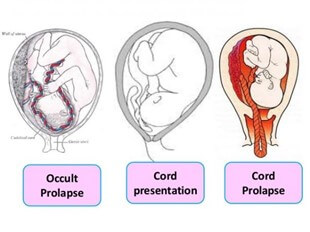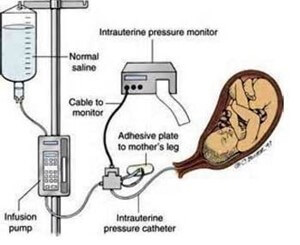A nurse is monitoring the fetal heart rate of a client who has a suspected occult cord prolapse.
Which of the following findings should the nurse expect?
Episodic accelerations
Fibrillation
Moderate tachycardia
Severe variable decelerations
The Correct Answer is D
The correct answer is choice D. Severe variable decelerations.
This is because occult cord prolapse occurs when the cord is compressed by the fetal presenting part, causing fetal hypoxemia. The fetal heart rate pattern may show severe bradycardia or severe variable decelerations, which indicate cord compression and fetal distress.
Choice A is wrong because episodic accelerations are normal and indicate fetal well-being. They are not associated with cord prolapse.
Choice B is wrong because fibrillation is a cardiac arrhythmia that affects the atria or ventricles of the heart. It is not a term used to describe fetal heart rate patterns.
Choice C is wrong because moderate tachycardia is a fetal heart rate above 160 beats per minute for more than 10 minutes.
It can be caused by maternal fever, infection, dehydration, fetal anemia, or fetal hypoxia. It is not a specific sign of cord prolapse.

Nursing Test Bank
Naxlex Comprehensive Predictor Exams
Related Questions
Correct Answer is D
Explanation
The correct answer is choice D. Severe variable decelerations.
This is because occult cord prolapse occurs when the cord is compressed by the fetal presenting part, causing fetal hypoxemia.The fetal heart rate pattern may show severe bradycardia or severe variable decelerations, which indicate cord compression and fetal distress.
Choice A is wrong because episodic accelerations are normal and indicate fetal well-being.They are not associated with cord prolapse.
Choice B is wrong because fibrillation is a cardiac arrhythmia that affects the atria or ventricles of the heart.It is not a term used to describe fetal heart rate patterns.
Choice C is wrong because moderate tachycardia is a fetal heart rate above 160 beats per minute for more than 10 minutes.
It can be caused by maternal fever, infection, dehydration, fetal anemia, or fetal hypoxia.It is not a specific sign of cord prolapse.

Correct Answer is ["A","B","C","E"]
Explanation
The correct answer is choice A, B, C and E. Here is why:
• Choice A is correct because informed consent is required before performing any invasive procedure, such as amnioinfusion.
• Choice B is correct because an intrauterine pressure catheter (IUPC) is needed to infuse fluid into the amniotic cavity and to monitor the uterine contractions.
• Choice C is correct because warmed sterile normal saline is the fluid of choice for amnioinfusion, as it mimics the natural amniotic fluid and reduces the risk of infection.
• Choice D is wrong because the client’s temperature should be monitored every 15 to 30 minutes, not every 4 hours, to detect any signs of infection or chorioamnionitis.
• Choice E is correct because the fetal heart rate and uterine activity should be assessed continuously to evaluate the fetal well-being and the effectiveness of amnioinfusion.
Amnioinfusion is a procedure that involves infusing fluid into the amniotic cavity to increase the amniotic fluid volume and to relieve umbilical cord compression.It can be used for clients who have oligohydramnios (low amniotic fluid) and cord compression, which can cause fetal growth restriction and abnormal fetal heart rate patterns.Amnioinfusion can improve the fetal blood flow and oxygenation by reducing the cord compression and variable decelerations.

Whether you are a student looking to ace your exams or a practicing nurse seeking to enhance your expertise , our nursing education contents will empower you with the confidence and competence to make a difference in the lives of patients and become a respected leader in the healthcare field.
Visit Naxlex, invest in your future and unlock endless possibilities with our unparalleled nursing education contents today
Report Wrong Answer on the Current Question
Do you disagree with the answer? If yes, what is your expected answer? Explain.
Kindly be descriptive with the issue you are facing.
